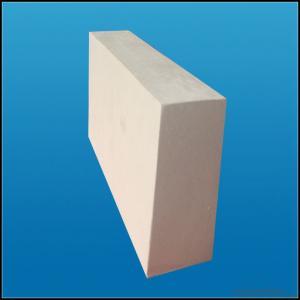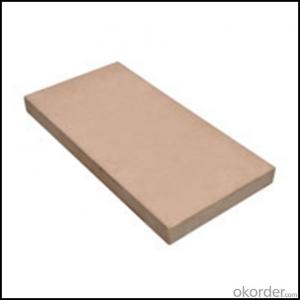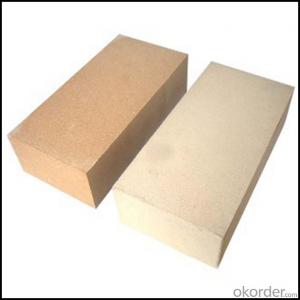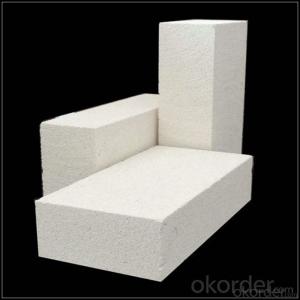SK32/34/36/38 Refractory Brick
- Loading Port:
- China main port
- Payment Terms:
- TT OR LC
- Min Order Qty:
- 0.01
- Supply Capability:
- 2600 m.t/month
OKorder Service Pledge
OKorder Financial Service
You Might Also Like
Acid Resistant Brick
CMAX firebricks are classified under temperature between 1300℃ to 1700℃, manufactured from high purity alumina clay.
High alumina refractory brick is dense shaped refractory material. With high refractoriness and mechanical behavior under high temperature, refractory brick is the necessary material of high-temperature services, mainly used for industrial furnaces and kilns and thermal equipment.
High alumina refractory brick has wide applications, mainly used in metallurgy, construction(cement and glass), petroleum, chemical industry, electric power and machine building.
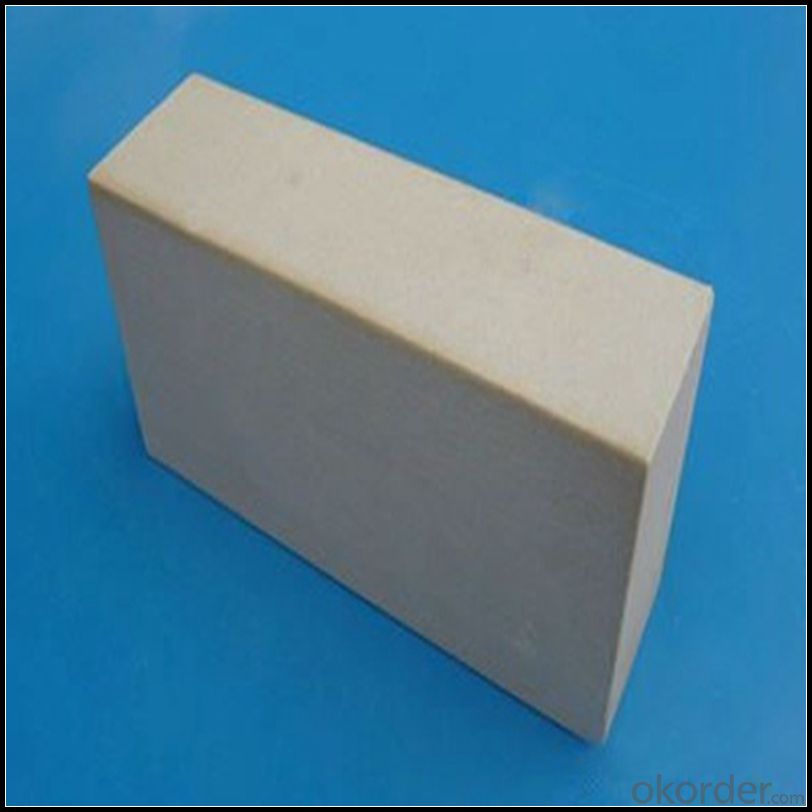
Features
1) Good thermal shock resistance
2) High-temperature endurable
3) Good thermal insulation
4) The using temperature is 1600 c
5) Phosphate high alumina bricks,iso
6) High strength
7) Low thermal conductivity
8) Widely used in cement kiln.
9) Low creeping rate
10) High pressure
11) Excellent thermal shock resistance
12) High quality fireclay clinker
Application
Iron & Steel Making Industry
Blast Furnace,Hot Blast Furnace(stove),Pellet Shaft Furnace,Hot Metal Ladle,Steel
Ladle, Tundish,Heating Furnace,Saking Pit Furnace,Heat Treatment Furnance.Refining Furnance,Reheating Furnance,Metal Mixter Furnance,Annealing Furnace,Cupola Furnace,Electric Arc Furnace,Induction Furnace,AOD Furnace,
cupola furnace,electric arc furnace,induction furnace,AOD furnace,VOD furnace,etc thermal technology equipment .
Non-Ferrous Metal Industry
Smelting furnace,refining furnace,reverberatory furnace,converter furnace
Building Materials Industy
cement kiln,glass kiln,ceramic kiln, lime kilns, kiln car,tunnel kiln
Energy & Incineration
Such as coke oven,general boiler,power generation boiler,circulating fluidized bed boiler,electric furnace,carbon roasting furnace,waste incinerators
Data Sheet
Classification Temperature (℉/℃) | 3000/1650 |
Bulk Density (g/cm3 ) | ≤1.0 |
Thermal Conductivity | |
800℃, W/m.K | ≤0.39 |
1000℃, W/m.K | ≤0.43 |
1200℃, W/m.K | ≤0.48 |
Reheating Linear Change (%) | 1550℃×12h |
≤0.9 | |
Chemical Composition (%) | |
Al2O3 | ≥75 |
Fe2O3 | ≤0.5 |
Packaging & Shipping
Packaging Details:Be packed in fumigated wooden pallets
Delivery Detail: 30 days after order

Our Services
Optimum solution and product supply of refractories for high temperature industries, such as iron steel, non-ferrous, petrochemical and building materials.
Engineering design, contract and consult for refractories, and civil architecture design.
Research, development, manufacture and sale of superhard materials.
R&D, manufacture and sale of special packing materials for export.
Inspection, supervision and arbitration of refractories.
Consultation and services in refractories information.
Training and cultivation of high-level talents in refractories profession
Sales Network

Company Information
CNBM (China National Building Material) Group is the largest comprehensive building materials group in China that in integrate scientific research, manufacturing and logistics into one entity. The largest building materials and equipment specialists in China. Upon State Council approval, today CNBM owned more than 300 subordinate manufacturing factories and servicing companies. There are 6 fully owned public listed companies and 11 partially owned with substantial shares public listed companies. In many of these fields, CNBM is playing the leading role in the building industry in the country.
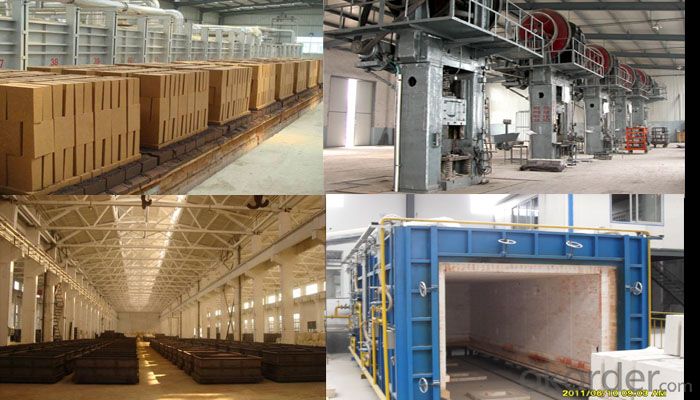
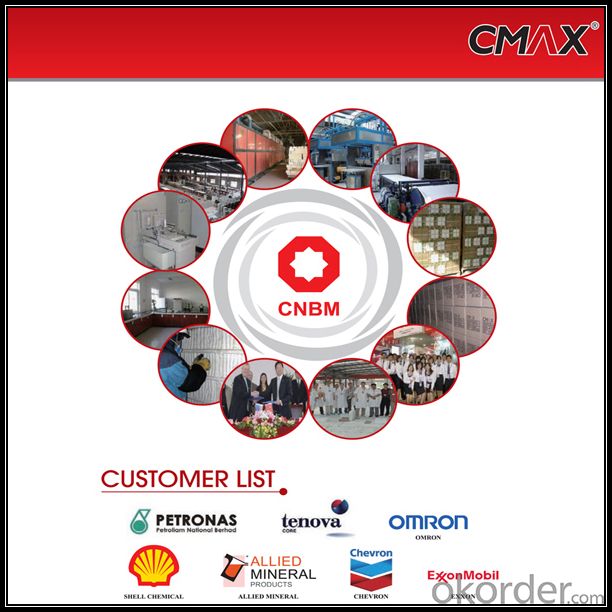
FAQ
1. Which products do you have?
We have all kinds of refractory brick, castable, mortar, cement, ceramic fiber products, etc.
Or you could browse our products to choose what you need.
2. Can you give me a brief introduction of the application of your products?
We are mainly specializing in the refractory materials in iron and steel, cement, glass, ceramics, petrochemical, electric power Industry, etc.
3. If I need your offer, what information do you need?
In order to choose suitable products, it will be appreciated to provide us the information, such us specification, technical data, order quantity, products application etc. If any question, please contact us freely.
- Q:Are insulating fire bricks resistant to high-velocity gas flow erosion?
- Yes, insulating fire bricks are generally resistant to high-velocity gas flow erosion. These bricks are specifically designed to withstand extreme temperatures and harsh conditions, including erosive environments. They are made from high-quality refractory materials, such as alumina and silica, which have excellent resistance to erosion and corrosion. Additionally, insulating fire bricks have a low thermal conductivity, which helps to reduce heat loss and maintain their structural integrity even under high-velocity gas flow. However, it is important to note that the exact resistance may vary depending on the specific composition and manufacturing process of the insulating fire bricks.
- Q:Can insulating fire bricks be used in residential applications?
- Residential applications can indeed make use of insulating fire bricks. These bricks are lightweight and possess exceptional thermal insulation properties, rendering them suitable for diverse residential purposes. They find utility in insulating fireplaces, wood-burning stoves, and chimneys, thereby contributing to enhanced energy efficiency and reduced heat loss. Moreover, insulating fire bricks can be employed in the construction of pizza ovens and outdoor grills, ensuring remarkable heat retention and insulation. Their ability to endure high temperatures makes them perfectly suited for such applications. In summary, insulating fire bricks present homeowners with a dependable and long-lasting solution to bolster insulation and heat retention in residential settings.
- Q:Can insulating fire bricks be used for insulation in heat recovery systems?
- Yes, insulating fire bricks can be used for insulation in heat recovery systems. Insulating fire bricks are specifically designed to withstand high temperatures and provide effective thermal insulation. They have low thermal conductivity, which means they can minimize heat loss and maximize heat recovery in a system. These bricks are often used in various industrial applications such as kilns, furnaces, and ovens, where temperature control and energy efficiency are important. Therefore, they can be a suitable choice for insulating heat recovery systems, helping to optimize the recovery and utilization of waste heat.
- Q:Are insulating fire bricks resistant to sulfates?
- Insulating fire bricks are generally resistant to sulfates. These bricks are made of high-alumina or silica materials, which have good chemical resistance properties. Sulfates are a type of chemical compound that can react with certain materials and cause degradation. However, insulating fire bricks are designed to withstand high temperatures and harsh chemical environments, including exposure to sulfates. They are often used in applications such as furnaces, kilns, and incinerators where they may come into contact with sulfates. Nevertheless, it is important to consider the specific composition and quality of the insulating fire bricks, as well as the concentration and duration of sulfate exposure, to ensure their long-term performance and durability.
- Q:Can insulating fire bricks be used in residential fireplaces?
- Residential fireplaces can indeed utilize insulating fire bricks. These specialized bricks are engineered to endure extreme temperatures while providing exceptional insulation, rendering them an apt option for constructing fireplaces. These bricks have the ability to retain heat, boost energy efficiency, and prevent heat loss. Moreover, they offer superior defense against thermal shock, a crucial element for enduring the intense heat produced by a fireplace. Furthermore, insulating fire bricks are lightweight, easy to manipulate, and can be effortlessly shaped or trimmed to fit any fireplace design or size. All in all, incorporating insulating fire bricks into residential fireplaces is a prudent decision for homeowners seeking to enhance their fireplace's performance and safety.
- Q:Can insulating fire bricks be used in the construction of melting furnaces?
- Yes, insulating fire bricks can be used in the construction of melting furnaces. Insulating fire bricks are designed to withstand high temperatures and have excellent thermal conductivity. They are specifically engineered to reduce heat loss and conserve energy, making them ideal for use in melting furnaces. In addition, insulating fire bricks are lightweight and easy to handle, making them convenient for construction purposes. They can effectively retain heat and maintain a stable temperature within the furnace, ensuring efficient melting and casting processes. Furthermore, insulating fire bricks are resistant to chemical corrosion and mechanical stress, making them durable and reliable for long-term use in melting furnaces. Overall, insulating fire bricks are a suitable choice for constructing melting furnaces due to their thermal properties, ease of use, and durability.
- Q:Are insulating fire bricks fireproof?
- Indeed, insulating fire bricks possess fireproof properties. Their design allows them to endure elevated temperatures while offering insulation to impede heat transfer. Composed of refractory materials with a high melting point, insulating fire bricks can withstand intense heat without disintegrating or liquefying. These bricks are frequently employed in scenarios involving high temperatures, such as kilns, furnaces, fireplaces, and ovens. As a means of fireproofing, insulating fire bricks are highly recommended due to their exceptional thermal insulation capabilities and their ability to effectively safeguard against the propagation of fire.
- Q:Are insulating fire bricks resistant to water absorption?
- Yes, insulating fire bricks are resistant to water absorption. These bricks are specifically designed to have low porosity and high density, which helps prevent water from being absorbed into their structure. This resistance to water absorption is important because exposure to water can lead to cracking or damage in fire bricks, reducing their insulation properties and overall longevity. Therefore, insulating fire bricks are an ideal choice for applications where moisture resistance is required, such as in the construction of kilns, furnaces, or other high-temperature environments.
- Q:Can insulating fire bricks be custom-made?
- Yes, insulating fire bricks can be custom-made. Insulating fire bricks are typically made from lightweight materials such as vermiculite, perlite, or refractory fibers, which can be easily molded into various shapes and sizes. This flexibility allows manufacturers to create custom-made insulating fire bricks to meet specific requirements and applications. Customization options may include variations in dimensions, thermal conductivity, compressive strength, and density. By tailoring the composition and design of insulating fire bricks, they can be optimized for specific temperature ranges, insulation requirements, and environmental conditions. Therefore, customers can work with manufacturers to develop custom solutions that best suit their unique needs.
- Q:Can insulating fire bricks be used in chimneys and flues?
- Insulating fire bricks are designed specifically for high-temperature usage and are commonly employed in industrial settings, furnaces, and kilns. While they possess exceptional insulating properties, they may not be the optimal choice for chimneys and flues in residential or commercial buildings. The primary reason for this is that insulating fire bricks lack the durability and heat resistance found in other materials specifically designed for chimney and flue construction. They have the potential to crack or break when subjected to the extreme heat and rapid temperature fluctuations that occur in chimneys. Moreover, these bricks are not typically engineered to withstand the corrosive effects of flue gases, which can result in their degradation over time. When dealing with chimneys and flues, it is generally recommended to utilize materials like clay flue liners, stainless steel, or refractory bricks that are specifically manufactured for these purposes. These materials are better equipped to handle the elevated temperatures, corrosive gases, and rapid thermal expansion and contraction that are inherent to chimneys. It is crucial to consult a professional chimney or flue specialist who can provide guidance on the suitable materials to employ based on the specific requirements and conditions of your chimney or flue system.
1. Manufacturer Overview |
|
|---|---|
| Location | |
| Year Established | |
| Annual Output Value | |
| Main Markets | |
| Company Certifications | |
2. Manufacturer Certificates |
|
|---|---|
| a) Certification Name | |
| Range | |
| Reference | |
| Validity Period | |
3. Manufacturer Capability |
|
|---|---|
| a)Trade Capacity | |
| Nearest Port | |
| Export Percentage | |
| No.of Employees in Trade Department | |
| Language Spoken: | |
| b)Factory Information | |
| Factory Size: | |
| No. of Production Lines | |
| Contract Manufacturing | |
| Product Price Range | |
Send your message to us
SK32/34/36/38 Refractory Brick
- Loading Port:
- China main port
- Payment Terms:
- TT OR LC
- Min Order Qty:
- 0.01
- Supply Capability:
- 2600 m.t/month
OKorder Service Pledge
OKorder Financial Service
Similar products
New products
Hot products
Related keywords
